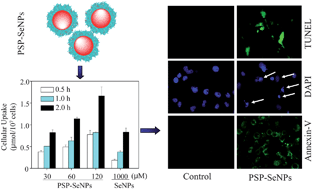Surface decoration of selenium nanoparticles by mushroom polysaccharides–protein complexes to achieve enhanced cellular uptake and antiproliferative activity
Abstract
By using mushroom

* Corresponding authors
a
Department of Chemistry, Jinan University, Guangzhou 510632, China
E-mail:
tchentf@jnu.edu.cn
b
Department of Applied Biology and Chemical Technology, The Hong Kong Polytechnic University, Hong Kong, China
E-mail:
bckhwong@polyu.edu.hk
By using mushroom

 Please wait while we load your content...
Something went wrong. Try again?
Please wait while we load your content...
Something went wrong. Try again?
H. Wu, X. Li, W. Liu, T. Chen, Y. Li, W. Zheng, C. W. Man, M. Wong and K. Wong, J. Mater. Chem., 2012, 22, 9602 DOI: 10.1039/C2JM16828F
To request permission to reproduce material from this article, please go to the Copyright Clearance Center request page.
If you are an author contributing to an RSC publication, you do not need to request permission provided correct acknowledgement is given.
If you are the author of this article, you do not need to request permission to reproduce figures and diagrams provided correct acknowledgement is given. If you want to reproduce the whole article in a third-party publication (excluding your thesis/dissertation for which permission is not required) please go to the Copyright Clearance Center request page.
Read more about how to correctly acknowledge RSC content.
 Fetching data from CrossRef.
Fetching data from CrossRef.
This may take some time to load.
Loading related content
